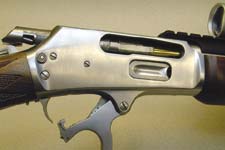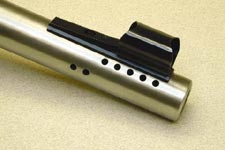September 23, 2010
By G&A Staff
According to Dick, Marlin's current-production lever actions are entirely modern hunting tools.
By Dick Metcalf
 M1894CP & M336SS In full-size stainless or compact blued configurations, Marlin's lever actions are the modern classics of American deer rifles. |
Nothing in the world of firearms is more purely American than a lever-action rifle, and Marlin (Dept. ST, 100 Kenna Dr., North Haven, CT 06473; www.marlinfirearms.com) has long been a leader in the lever-action world. The current .22 Long Rifle Marlin Model 1897 Cowboy and Marlin Golden 39A rifles, as Marlin points out with pride, represent the oldest shoulder firearm design in continuous production anywhere in the world. In fact, the Marlin Model 1891 (the Model 39's great-grandfather, as the company history puts it) was the first repeating rifle to be chambered for the .22 LR cartridge. Last year Marlin cataloged 24 individual lever-action centerfire and rimfire rifle models in 11 chamberings ranging from the powerful .450 Marlin to the dainty .22 LR in full-length, carbine, or cowboy action styling; stainless steel or blued steel; with checkered wood or camouflage-finished stock and forend. And Marlin executives say there will be more new versions to come this year.
Beginning with the introduction of its wildly popular Guide Gun version of the big-bore .45-70 Model 1895 in 1998 (blued steel, 181/2-inch ported barrel, four-shot magazine, deep-cut six-groove Ballard rifling, and ventilated recoil pad) and continuing with the same-format Model 444P Outfitter in .444 Marlin the next year and the introduction of the .450 Marlin-chambered Guide Gun in 2000, Marlin has been on a roll. These new models have created a renaissance for big-bore lever-action woods and brush hunting guns among serious hunters from the eastern U.S. to Alaska and Africa. Marlin's headliner introduction in this series last year was the new Model 1895GS, a stainless-steel version of the .45-70 1895 Guide Gun. The Model 1895GS is the company's second stainless rifle, following the introduction in 2000 of the .30-30 Model 336SS, which was the first-ever standard-production stainless-steel lever gun to be made in America. All major parts of both guns are fabricated from stainless steel--including receiver, barrel, lever, trigger guard plate, magazine tube, forearm/magazine tube bands, and loading gate. Nonstainless metal parts (like the sling-swivel studs) are satin nickel plated for compatible appearance. The open semibuckhorn sights are blued.
Advertisement
Without going into extreme technical detail, it is useful to note that the Marlin Model 336 series and the Model 1895 series are essentially the same-design guns with the 1895 and 444 models being big-bore chambered and the 336 available in .30-30 and .38-55. All feature solid-receiver side ejection, which allows scope mounting on the drilled-and-tapped receiver top. Both series also offer parallel configuration variations: straight-grip versions with straight levers or pistol-grip versions with curved levers; barrel-band magazine attachment or forearm clamp magazine attachment; tapered forearms or semibeavertail forearms; full-length magazine tubes or short tubes.
Advertisement
All these guns also feature the manual crossbolt hammerblock safety that has been a Marlin standard since 1984. All the company's centerfire lever-action rifles also have three additional significant safety features. The first is the diagnostic Marlin two-piece firing pin, which dates from the original Model 1893 design and provides for the rear section of the pin to drop out of alignment with the front until the locking bolt is fully engaged. A trigger block also prevents the trigger from being pulled until the lever is fully closed. There is a traditional halfcock hammer safety position as well.
 The solid-top receiver design of Marlin lever-action rifles provides the strength necessary to handle powerful big-bore loads like the .450 Marlin. |
Performance To Spare
Marlin provided Shooting Times with a review sample .45-70 stainless Model 1895GS late last summer and also gave me the opportunity to try it out in the field on an October whitetail hunt on Quebec's famed Anticosti Island. When the rifle arrived at my door, I went right to work checking its performance with several varieties of ammo and setting it up for hunting. It was a beautiful gun right out of the box with clean-cut checkering on the straight-grip American walnut stock and forearm, a soft satiny luster to the natural stainless metal, and the quick-handling balance in the 181/2-inch barrel design that made the Guide Gun format such an instant hit in the first place. Some traditionalists have grumbled a bit about the whole idea of a stainless-steel lever-action rifle, but I think it's great. Marlin's current rifles are entirely modern hunting tools and stainless is just right for damp hunting conditions like those typically encountered on Anticosti Island, which is smack dab in the middle of the Gulf of St. Lawrence.
While the receiver-optics feature of Marlin's lever-action guns are one of their stronger selling points to most hunters, I have always preferred barrel-location Scout-type mounts for heavy-caliber brush rifles so I set up the 1895GS with a Leupold 4X EER pistol scope using one of AO Sight Systems's (Dept. ST, 2401 Ludelle St., Ft. Worth, TX 76105; phone: 888-744-4880; www.aosights.com) dandy little Lever Scout mount bases. It provides a long, flat aluminum rail full of standard Weaver crosscuts for maximum flexibility in ring positioning--there is a wide variation in eye-relief among different forward-mount optics. It utilizes both the forward receiver screw-holes and the rear sight dovetail in the barrel for maximum strength in attachment. Proof of the pudding is that it withstood all my review firing with even the heaviest of .45-70 loads without a flinch. My only criticisms of AO are that the mount is not available yet in a stainless-compatible finish and it is not offered for Marlin's smaller dimension Model 1894 series.
To check the gun's performance I selected six different varieties of commercial .45-70 ammunition. Loads ranged from Winchester's light and fast 300-grain Supreme Partition Gold to Garrett's rhino-busting 540-grain +P SuperHardCast HammerHead (which is designed to be used only in Marlin lever-action guns). The results are listed in the accompanying chart.
 The standard-issue ported 18.5-inch barrels and cushioned recoil pads on the .45-70 and .450 Marlin Guide Guns provide substantial reduction in felt recoil. |
The shooting was interesting. The .4
5-70 cartridge is a renowned heavy kicker, particularly with heavy loadings like Garrett's. Spending an afternoon with a .45-70 at a locked-in benchrest is usually about as much fun as a week full of 12-gauge three-inch magnum slug shooting, but the standard-issue porting and factory-issue vent recoil pad of the Marlin Guide Gun configuration made a notable difference. Even the heaviest loads were in no way really punishing, and I could shoot the lighter 300-grain ammo for as long as I wanted without really thinking about it.
Performance was excellent. The Winchester Supreme was tops in accuracy in the sample 1895GS, averaging just over an inch at 100 yards--accuracy I consider exceptional in a lever gun. And I should also assure you that the ballistic figures shown for the Garrett 540-grain load are not a misprint. Standard deviation was zero! When I looked at that printout tape from the Oehler M35 chronograph the first time, I thought: "Uh-oh, false reading." There was only one fps spread showing between the fastest and slowest rounds. So I did another five-shot string, and it came up with a mere two fps spread and a standard deviation of 1.0. So I listed the first reading. That's the first time I have seen that happen in over 30 years of chronographing ammunition. Garrett loads an extremely consistent cartridge, but for whitetails a 540-grain hardcast load that will shoot lengthways through a Cape buffalo (actually verified) might reasonably be considered excessive so I sighted-in with the most accurate and flattest shooting Winchester Supreme 300-grain load for the Canadian hunt. Anticosti offers mixed terrain, thick woods forest interspersed with miles-across swampy tundra clearings, so I stretched my point-blank trajectory as far as the load would reasonably allow, zeroing at 150 yards for a four-inch rise at 100 and a 12-inch drop at 200. Thanks to the gun/load's superb accuracy and modern compact rangefinder technology, I could be confident anywhere within that zone.
 The hunting on Anticosti island proved successful for Dick and Marlin's Tony Aeschliman (R). Dick dropped this 10-pointer at 150 yards with the .30-30 M336SS and Winchester's 150-grain moly-coated Power-Point Plus load. |
Variety In The Field
As the hunt date approached, I learned that each of the six people comprising our party (various writers and Marlin company personnel) had been sent a different model of gun: three Marlin lever actions and three break-open H&R and New England Firearms single shots. (Marlin purchased those two companies over a year ago and continues to produce the product lines under their traditional brand names.) It was a good thing Marlin sent everyone a different gun because my Model 1895GS didn't get to Canada with me. It was misdirected in baggage, and we couldn't wait in the Montreal airport before catching the once-a-week backcountry charter flight. (My rifle eventually bounced back off Canadian customs and was waiting for me at my home airport in the U.S. when I returned 10 days later.) So I hunted with "borrowed" guns--which, since everybody had tags for two deer, was part of what Marlin's Tony Aeschliman had in mind by having such a selection available in the first place. We'd shoot our first animal with one gun, the second with another. Tony and another hunter who had driven from the U.S. to Montreal had each brought two guns so there were spares. The result was I got to field-try more products than I had originally expected.
Most of the week I hunted alone in thick forest terrain or along the brushy margin of the open tundra patches and carried one of the new-for-2001 Marlin Model 1895CP .44 Magnum carbines. This delightful little carbine sports a 161/4-inch barrel that is ported and configured to parallel the bigger 1985 Guide Guns. It's so light (only 53/4 pounds) that it's exceptionally convenient in the tangled Canadian thickets. However, on the morning that I was helicoptered to a remote area of the island with more extensive open areas to be dropped off solo for a full day of trackless compass-wandering, I opted for something with a little more reach and carried a scoped stainless Model 336SS in .30-30.
That was the right choice because at the end of the day I got to within 150 yards of as good a 10-point buck as you're likely to see on Anticosti and put him away with one knockdown round of Winchester's 150-grain moly-coated Power-Point Plus. Two days later, back in the woods closer to base camp with the little .44 Magnum 1894CP again, I filled the second tag with an antlerless meat-rack animal that fell to a point-of-aim neck shot at 30 yards with Winchester's 250-grain Partition Gold bullet.
All hunters in our group filled their tags, and Aeschliman took his eight-point trophy using a 20-gauge H&R Ultra Slug Hunter offhand at 80 yards with Winchester's new Supreme Partition Gold Sabot load. It was a superbly accurate combination, and I'll be using it myself during one of our Illinois slug-only whitetail seasons. Other successful guns in camp included an H&R Ultra Rifle in .450 Marlin and a New England Firearms Synthetic Handi-Rifle in .243 Winchester.
Given my recent success with the other two Marlin lever guns, I anxiously anticipate using the new stainless Model 1895GS .45-70 on another hunt.
| MARLIN'S HUNTING LEVER ACTIONS | | Model | 1895GS | 1894CP | 336SS | | Caliber: | .45-70 Govt. | .44 Magnum | .30-30 | | Barrel Length: | 18.5 in. | 16.25 in. | 20 in. | | Overall Length: | 37 in. | 33.25 in. | 38.5 in. | | Weight, empty: | 7.0 lbs. | 5.75 lbs. | 7.5 lbs. | | Safety: | Manual crossbolt | Manual crossbolt | Manual crossbolt | | Sights: | Folding semibuckhorn rear;
brass bead front with hood;
receiver drilled and tapped | Folding semibuckhorn rear;
brass bead front with hood;
receiver drilled and tapped | Folding semibuckhorn rear;
brass bead front with hood;
receiver drilled and tapped | | Rifling: | Ballard 6 groove,
1:20 RH twist | Ballard 6 groove,
1:16 TH twist | Micrro-Groove 12 groove,
1:10 RH twist | | Stock: | American Walnut | American Walnut | American Walnut | | Magazine Capacity: | 4 rounds | 8 rounds | 6 rounds | | Finish: | Satin stainless steel
Mar-Shield wood | Satin blued steel
Mar-Shield wood | Satin stainless Steel
Mar-Shield wood | | Price: | $719 | $546 | $608 |
|
|
